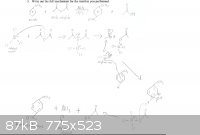
Magelia - 8-11-2011 at 14:54
Hi Colleagues,
I drew out the mechanism for the Friedel-Crafts Acylation, and I was wondering if it was correct! Please see below
The part I am unsure about is if it is the oxygen attached to the AlCl3 complex that removes the hydrogen to give the molecule its aromaticity back.

[Edited on 8-11-2011 by Magelia]
MagicJigPipe - 8-11-2011 at 21:42
It seems to me that the electrons in the Al-O bond would go to the oxygen, leaving neutral AlCl3 and acetate. Acetate would then abstract the proton
from the ring. Just reverse the direction of the arrow between Al and O (and write negative charge on Al!) and that would be the same as what I just
said but all in one step.
You are leaving the negative charge off of the Al and I don't think the Al-O bond's electrons would go to Al (being negatively charged and all).
Please note that I have only had 2 classes of undergraduate org. chem. and am no where near an expert. I'm just trying to help as I couldn't find the
specific mechanism on the internet.
DJF90 - 9-11-2011 at 08:26
Most of it looks ok, as you're going via the acylium cation. The one thing I will say is that the AlCl3 catalyst is not really a catalyst in the
Freidel-Crafts acylation - the oxygen atom in the product chelates the Aluminium and so a stoichiometric/superstoichiometric quantity is
required. The mechanism is the same for an acyl chloride as your reagent (chlorine lone pair chelates Aluminium, carbonyl oxygen lone pair "kicks in"
to displace [AlCl4]- and form the acylium ion).
kavu - 9-11-2011 at 11:53
Apart from what DJF90 said, there is also a slight problem where you expected one to be. You deprotonate the arenium ion using aluminium trichloride
complex. The aluminium is namely bearing a negative charge and yet you push electrons to it. One way to represent the deprotonation step would be to
draw an arrow from the Al-O bond through the oxygen and to the hydrogen on the arenium ion. Usually a rule of thumb is that in a given step of
mechanism electrons flow in the same general direction towards the electrophile.
Another thing you might want to consider is the geometry of the aromatic molecules. Carbons of benzene ring are sp² hybridized and thus (apart from
really funky groups) bonds from benzene are not bent. It is good practice to draw the geometry as predicted.
[Edited on 9-11-2011 by kavu]
